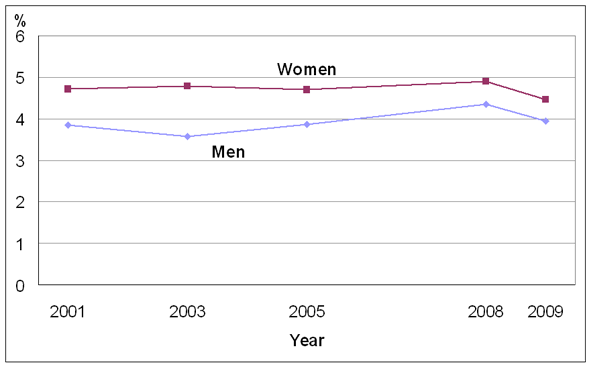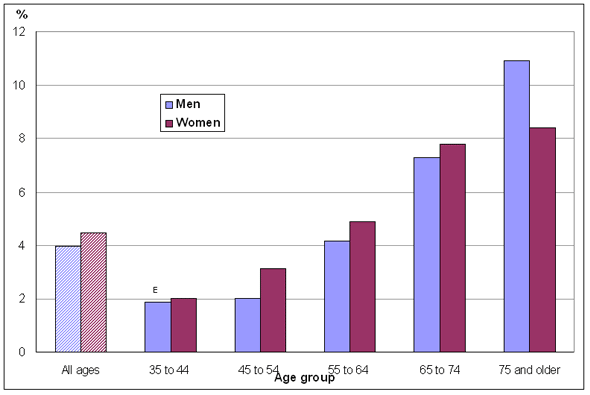Chronic Obstructive Pulmonary Disease, 2009
Archived Content
Information identified as archived is provided for reference, research or recordkeeping purposes. It is not subject to the Government of Canada Web Standards and has not been altered or updated since it was archived. Please "contact us" to request a format other than those available.

Chronic obstructive pulmonary disease (COPD) is an umbrella term that describes chronic lung diseases that limit airflow to the lungs. The two most common COPD diseases are emphysema and chronic bronchitis. Symptoms include shortness of breath, as well as wheezing and coughing that produce mucus. As the disease progresses, the ability to perform routine activities may become limited.1
In 2009, 4.2% of Canadians aged 35 and older—4.0% of men and 4.5% of women—reported that they had been diagnosed with COPD (Chart 1). This was not a significant change from 4.6% of Canadians in 2008.
From 2001 to 2005, women were more likely than men to report COPD, but in 2008 and 2009 there was no significant difference between the sexes (Chart 1).
Chart 1
Percentage diagnosed with chronic obstructive pulmonary disease, by sex, household population aged 35 and older, Canada, 2001 to 2009

Source: Canadian Community Health Survey, 2001, 2003, 2005, 2008 and 2009.
Among men, COPD rates were steady from ages 35 to 54, and then increased with age. For women, COPD rates increased with age starting with the ages 35 to 44, and then levelled off at age 65 (Chart 2).
At ages 45 to 54, women (3.1%) were more likely than men (2.0%) to have COPD, but at age 75 and older men (10.9%) were more likely than women (8.4%) to have COPD (Chart 2). There were no significant differences between the sexes in the other age ranges.
Chart 2
Percentage diagnosed with chronic obstructive pulmonary disease, by age group and sex, household population aged 35 and older, by age group and sex, Canada, 2009

Note:
E Use with caution (coefficient of variation 16.6% to 33.3%).
Source: Canadian Community Health Survey, 2009.
Smoking is the leading cause of COPD, although exposure to lung irritants such as second-hand smoke, air pollution and chemical fumes can also contribute.2 In 2009, 7.2% of smokers aged 35 and older reported having COPD, compared with 4.7% of former smokers and 2.0% of those who had never smoked.
Two provinces reported higher rates of COPD compared to the national average: Nova Scotia, 7.0%, and Quebec, 4.8%. Alberta, at 3.3%, was lower than the national average.
Because of the strong relationship between age and COPD, a province or territory with a disproportionately 'younger' population would be expected to have a COPD rate below the national average. Conversely, a province or territory with an 'older' population should have a higher COPD rate than the national average. To remove the effect of different age distributions, the COPD rates were recalculated as if the age groups in each province and territory were the same as at the national level. Based on these calculations, only Nova Scotia had a higher rate than the Canadian average. The age–standardized rates in the other provinces and territories were not significantly different from the national rate.
End notes
1.
The Lung Association. Lung Diseases, COPD. http://www.lung.ca (accessed May 10, 2010).
2. Ibid.
This question was not asked in 2007.
References
The Lung Association. Lung Diseases, COPD. http://www.lung.ca (accessed May 10, 2010).
Data
Additional data from the Canadian Community Health Survey are available from CANSIM table 105–0501.
- Date modified:
